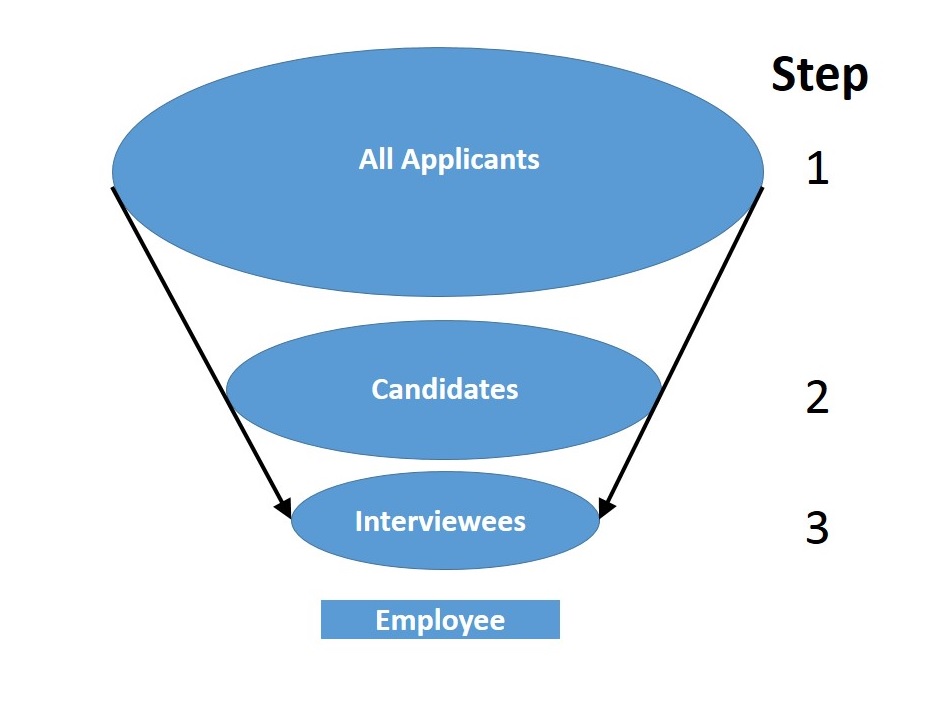 In my experience, most cultural resource management companies do not like to hire new employees. New hires take time to get up to speed. A CRM archaeology PI once told me it takes 18 months to two years just to get a new field tech, crew chief, or principal investigator trained and accustomed to their new habitat. That’s 18 to 24 months of training even for skilled recruits!
In my experience, most cultural resource management companies do not like to hire new employees. New hires take time to get up to speed. A CRM archaeology PI once told me it takes 18 months to two years just to get a new field tech, crew chief, or principal investigator trained and accustomed to their new habitat. That’s 18 to 24 months of training even for skilled recruits!
The time investment is the main aspect of hiring that companies dislike, which is why the decision to hire new employees is not taken lightly. It takes time to think through the decision to hire new employees, so, by the time you see a job posting, the company has already invested considerable effort into the decision to hire.
Because we’re usually disassociated from the job hiring decision, it’s easy for most CRM job seekers to be fixated solely on the final goal—getting a job. But, it is fruitful to think about the processes that are set in motion by the simple decision to hire a new employee and the decision to do this hiring on the open market through a job posting.
Introducing, the Archaeology Job Hiring Funnel
This week, I’ve been working my way through Robert A. Potter’s book “Winning in the Invisible Market: A Guide to Selling Professional Services in Turbulent Times” (2003). Potter focuses on researching potential clients in hopes of figuring out whether or not they are ready to purchase professional services, like CRM consulting. He frequently remarks that the most successful professional service companies are the ones that can find clients who are ready to buy professional services and then demonstrate how their services will solve problems while also achieving their client’s goals.
I was quickly reminded of a book I read last winter called “Cracking the Hidden Job Market: How to Find Opportunity in Any Economy” by Donald Asher (If you haven’t already, I highly recommend reading my post Cracking the Hidden Archaeology Job Market). Whereas Asher focuses on winning the job search game, Potter is talking about getting more sales. Both books are a must read for anyone looking for forge a durable career in cultural resource management.
Here’s a video that explains the Archaeology Job Hiring Funnel:
Reading Winning in the Invisible Market reminded me of how most companies go about the job hiring process. CRMers prefer to hire people they know or folks that have been recommended to them. This completely cuts out the applicant screening process and helps them find new talent without having to work for it. Jobs gained through networks or referrals is what I meant by hidden job market. There was no job posting. No shovelbums advert. Just a quick and painless interview just to see if you’re not a psycho. Despite the fact that there are dozens of jobs on shovelbums.org and archaeologyfieldwork.com, most jobs in CRM exist in the hidden job market.
However, sometimes, companies cannot fill their needs simply through personal connections and networking. Sometimes, they have to file job postings and work the visible job spectrum. This is where understanding the job funnel comes into play.
The archaeology job funnel is similar to the sales funnel that is well known to salespeople. Basically, companies issue a job posting and field resumes (Step 1), then they winnow down the stack to a few candidates (Step 2), before interviewing the best candidates (Step 3). At the end of this process, a new employee is born.
Here are a few things to consider about each step in the process:
Step 1—By the time a job posting is created, the company has gone through a pretty detailed discussion of whether or not they need to hire. If it’s for a single project, the company is interested in finding people that can actually do the job but they’re not just looking for anyone with a pulse. They want an archaeologist with “a very peculiar set of skills”. This is reflected in the text of the job posting.
The most important thing to remember about this step is, you need to figure out a way to make it through the pool of applicants. Your resume and cover letter need to stand out and be very specific to the job description. An application package with all the right keyword optimization and properly highlighted knowledge, skills, and abilities should do the trick.
Step 2—A smaller bowl of candidates will be collected from the large trough of applicants. By this time, a CRM company has done the dirty work of sorting through the overburden in order to reach a pool of qualified folks that can do the job. Most of these people will be interviewed.
You need to know that, although the company has a specific person in mind when they wrote the post, the probably won’t get that dream candidate. There are a lot of reasons why the most suitable candidate will not be found (crappy resume, poor references, already employed elsewhere, does not exist, ect.). You just need to make sure your resume and cover letter are optimized to the job post and that you look like a true contender if you want to get an interview.
Step 3—The interview process for most positions is usually a formality. Based on the application package, the company is pretty sure they already know which candidate(s) is going to get the job; however, the interviews may shake things up. Underestimated candidates may prove themselves and beat out other preferred candidates.
You can’t game the system by Step 3. Either you are the droid they’re looking for or you are not. However, there are things you can do to make your interview go better than the competition.
Remember, you are trying to align your value as an employee with their needs as a business. Companies need to make money in order to be successful. They make that money through the skills and effort of their employees. In order to position yourself as the answer to their needs—their Dream Employee—you will need to do some background research. Basically, you need to:
- Collect information about the company (i.e. Where are they located? In which parts of the country do they work?).
- What they do? (i.e. Who are their clients? What industries do they service?)
- Who already works there?, and
- What are the research interests of their current employees?
Then, you need to align all your information to demonstrate how you can help achieve their goals. This means you tailor your resume, cover letter, LinkedIn, and any other form of reference material to their needs as a business.
Robert Potter calls this “Value Mining” because you are trying to demonstrate how you can add value to their company. According to Potter, Value = Purpose Pain. In other words, companies will not make the decision to hire unless they have come to the conclusion that the benefit of hiring a new employee to help them achieve their business’ purpose outweighs the pain of going through the hiring process. By demonstrating that hiring you will greatly help them achieve their purpose (i.e. completing a project, finding new clients, fixing existing problems), you are explaining your value to them. This message is what you convey in your interview.
Nobody said it’d be easy
It takes time to get hired through the applicant selection process, which is why I always suggest working your network and harnessing the hidden job market. Finding jobs in the hidden job market also takes time, but, with skill, you can get to the point where companies are calling you to see if you’re available rather than the other way around.
Knowing the job funnel will help you survive in the visible job market. By taking a few hours to research potential employers before you apply to a job posting, you are collecting valuable data that can be used to demonstrate your value as an employee once you get to the interview stage. It also makes you more aware of the mechanics behind the applicant screening process and the way companies come to the conclusion that they need to hire a new employee.
At the end of the day, getting a job in cultural resource management archaeology takes knowledge and effort but the reward is more than worth it. You get to prove everybody wrong when you beat the odds and land a job that less than 20,000 Americans enjoy.
Write a comment below or send me an email and keep the conversation about the archaeology job hiring process going.
Check out Succinct Research’s most recent publication Blogging Archaeology. Full of amazing information about how blogging is revolutionizing archaeology publishing. For a limited time you can GRAB A COPY FOR FREE!!!! Click Here
 “Resume-Writing for Archaeologists” is now available on Amazon.com. Click Here and get detailed instructions on how you can land a job in CRM archaeology today!
“Resume-Writing for Archaeologists” is now available on Amazon.com. Click Here and get detailed instructions on how you can land a job in CRM archaeology today!
 Small Archaeology Project Management is now on the Kindle Store. Over 300 copies were sold in the first month! Click Here and see what the buzz is all about.
Small Archaeology Project Management is now on the Kindle Store. Over 300 copies were sold in the first month! Click Here and see what the buzz is all about.
Join the Succinct Research email list and receive additional information on the CRM and heritage conservation field.
Get killer information about the CRM archaeology industry and historic preservation.





Your giving away trade secrets there Bill that have taken me 20 years of fieldwork to learn the hardway….oh well. .I always do background research on the staff and company I am trying to get hired by. I will pull the vitas of their primary CRM staff (usually findable on the internet, since major projects often include “key personnel” vita sections). I try and find projects that we may have had in common or people that we both know or have worked with (hint- these then make great recommendation choices). I will also check their websites to see what projects they list as “best work” and then go down to the local SHPO office and pull the reports/projects they have done for the last year or so to see where they are primarily working and who they have as primary clients. Being informed in an interview is key and makes you look like a serious professional. Its a bit like “name dropping” at a conference, “Well, I have a lot of experience in —- projects, like that one your company did last year for Client X”….”Well, you already have a lithic expert in Bob there, but I don’t think you have a faunal expert, are you subcontracting that work now? I can bring that skill-set to the team so you can keep it in house” …………………..I’ve had interviewers mouths fall open when you can do that kind of stuff.
Amazing stuff, Ryan. It totally works doesn’t it?